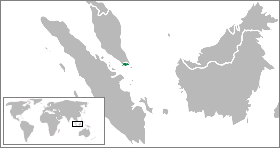Singapore (Chinese: 新加坡; pinyin: Xīnjiāpō; Malay: Singapura; Tamil: சிங்கப்பூர், Cingkappūr), officially the Republic of Singapore, is an island city-state located at the southern tip of the Malay Peninsula, lying 137 kilometres (85 mi) north of the equator, south of the Malaysian state of Johor and north of Indonesia's Riau Islands. At 710.2 km2 (274.2 sq mi),[7] Singapore, a microstate and the smallest nation in Southeast Asia, is by orders of magnitude larger than Monaco and Vatican City. These, as well as San Marino, are the only other surviving sovereign city-states.
Before European settlement, the island now known as Singapore was the site of a Malay fishing village at the mouth of the Singapore River. Several hundred indigenous Orang Laut people also lived along the nearby coast, rivers and on smaller islands. In 1819, the British East India Company, led by Sir Stamford Raffles, established a trading post on the island, which was used as a port along the spice route.[8] Singapore became one of the most important commercial and military centres of the British Empire, and the hub of British power in Southeast Asia.
During the Second World War, the British colony was occupied by the Japanese after the Battle of Singapore, which Winston Churchill called "Britain's greatest defeat".[9] Singapore reverted to British rule in 1945, immediately after the war. Eighteen years later, in 1963, the city, having achieved independence from Britain, merged with Malaya, Sabah, and Sarawak to form Malaysia. However, the merger proved unsuccessful, and, less than two years later, it seceded from the federation and became an independent republic within the Commonwealth of Nations on August 9, 1965. Singapore was admitted to the United Nations on September 21 of that year.
Since independence, Singapore's standard of living has risen dramatically. Foreign direct investment and a state-led drive to industrialization based on plans drawn up by the Dutch economist Albert Winsemius have created a modern economy focused on industry, education and urban planning.[10] Singapore is the 5th wealthiest country in the world in terms of GDP (PPP) per capita.[11] In December 2008, the foreign exchange reserves of this small island nation stood at around US$174.2billion.[12] The Singapore government, with approval from the President, announced in March 2009 that it would tap into her official reserves for the first time ever, and withdraw some S$4.9 billion. The funds were then used as part of the S$20.5 billion resilience package unveiled by Finance Minister Tharman Shanmugaratnam on 5 February 2009. As of January 2009, Singapore's official reserves stands at US$170.3 billion.
In 2009, the Economist Intelligence Unit ranked Singapore the tenth most expensive city in the world in which to live—the third in Asia, after Tokyo and Osaka.[13] The 2009 Cost of Living survey, by consultancy firm Mercer, has ranked Singapore similarly as the tenth most expensive city for expatriates to live in.[14]
The population of Singapore is approximately 4.86 million.[5] Singapore is highly cosmopolitan and diverse with Chinese people forming an ethnic majority with large populations of Malay, Indian and other people. English, Malay, Tamil, and Chinese are the official languages.[15]
Singapore is a parliamentary republic, and the Constitution of Singapore establishes representative democracy as the nation's political system.[16] The People's Action Party (PAP) dominates the political process and has won control of Parliament in every election since self-government in 1959.
Contents
- 1 Etymology
- 2 History
- 3 Government and politics
- 4 Geography and climate
- 5 Economy
- 6 Foreign relations
- 7 Military
- 8 Demographics
- 9 Culture
- 10 Architecture
- 11 Resources
- 12 Transport
- 13 See also
- 14 Notes
- 15 References
- 16 External links
- 17 Gallery















No comments:
Post a Comment